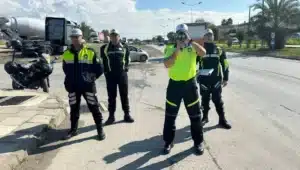Police traffic teams across the country checked 2,415 drivers yesterday. A total of 434 drivers were reported for various traffic offences, with legal action* taken against them. Additionally, 42 vehicles were banned from the roads, and one driver was arrested, Yeniduzen reported.
According to the police, the reported traffic violations include: 162 for speeding, 15 for driving under the influence of alcohol, 3 for driving without a licence or insurance, 51 for using a mobile phone while driving, 13 for not wearing a seatbelt, 18 for driving without vehicle registration, 5 for driving without insurance, 2 for not obeying traffic lights, 2 for dangerous driving, and 163 for other traffic violations.
*Driving standards in the North Cyprus tend to be poor due to a combination of factors:
Lack of Enforcement: Traffic laws are not always strictly enforced in the TRNC. People may flout rules like speeding, seatbelt use, and using mobile phones while driving because they know that there is a low likelihood of being caught or fined. This undermines safe driving habits and encourages a lax attitude toward road safety.
Infrastructure Issues: The road infrastructure in the TRNC can sometimes be below standard, with potholes, inadequate signage, and poorly maintained roads contributing to unsafe driving conditions. Bad road surfaces can lead to accidents, and insufficient signs or warnings can confuse drivers, especially tourists.
Cultural Attitudes: Some drivers in the TRNC have a casual attitude toward traffic rules and safety, stemming from a cultural norm where informal driving practices are more common. This can include behaviours like overtaking on dangerous corners, not using indicators, and parking indiscriminately, contributing to lower driving standards overall.
Driver Training: The quality of driver training and testing may not be as rigorous as in some other countries, leading to drivers who are less prepared for the challenges of the road. People may pass their driving test with minimal preparation, meaning they have a lower level of driving skill and awareness.
High Number of Visitors: The TRNC sees a large number of tourists, many of whom may be unfamiliar with driving on the left-hand side of the road (a legacy from British rule). This can lead to confusion and accidents, especially at roundabouts or junctions.
Older Vehicles: Many cars in the TRNC are older and may not have the latest safety features or may not be well-maintained, making them more prone to accidents or mechanical failures.
These factors together create an environment where driving standards appear lower than in many other parts of Europe, contributing to higher accident rates and general dissatisfaction with road safety. [Ed.]




